Chess Notes
Edward Winter
When contacting us by e-mail, correspondents are asked to include their name and full postal address and, when providing information, to quote exact book and magazine sources. The word ‘chess’ needs to appear in the subject-line or in the message itself.
| First column | << previous | Archives [168] | next >> | Current column |
10899. Yugoslav photographs
A selection of illustrations from the short-lived magazine Šah (published in Maribor), showing Vladimir Vuković, a group photograph of Celje, 1921, Isidor/Izidor Gross, Milan Vidmar, Jakov Ovadija, Boris Kostić and José Raúl Capablanca:
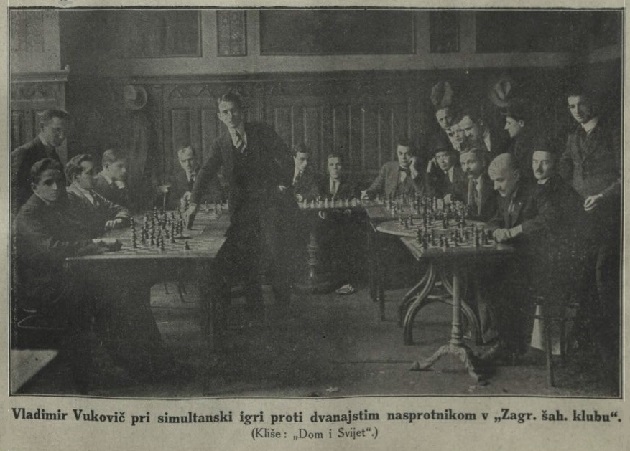
Šah, September-October 1922, page 28

Šah, September-October 1922, pages 28-29
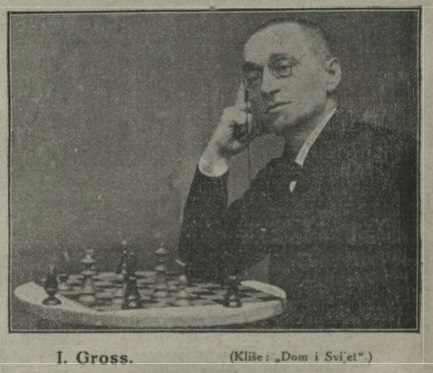
Šah, November-December 1922, page 33
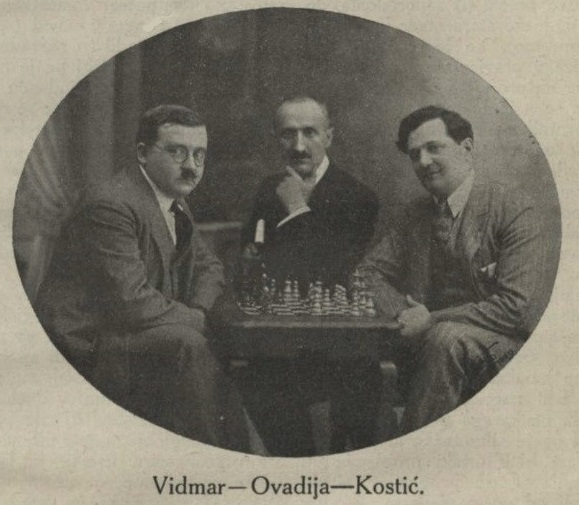
Šah, January-February 1923, page 49

Šah, January-February 1923, page 57
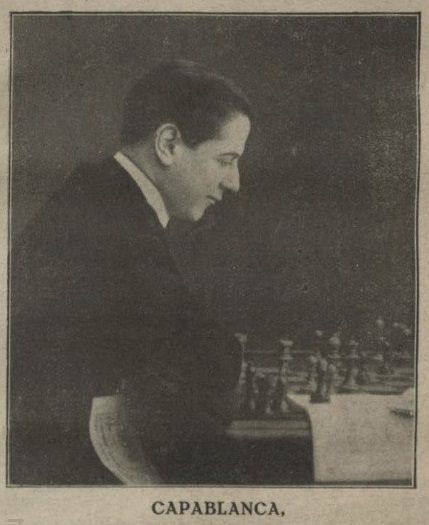
Šah, March-April 1923, page 65
The above is part of a photograph of Capablanca in play against Yuly Sosnitsky on page 82 of the February-May 1914 Wiener Schachzeitung:
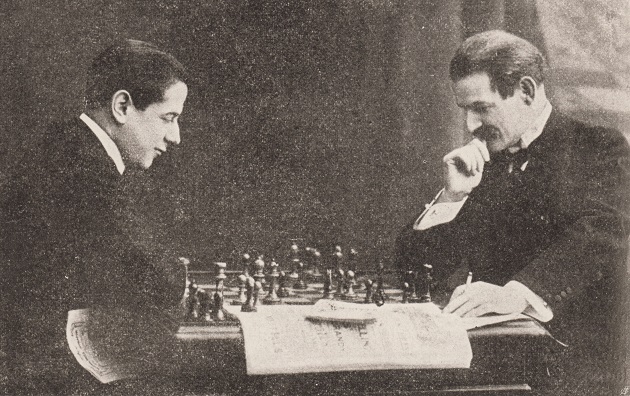
10900. Nicifor v Kramer
Page 9 of Šah, July-August 1922:

As stated in the section-heading on page 7, ‘Partije iz glavnega turnirja v Celju 1921’, this game was played in the Celje tournament of which the group photograph was shown in C.N. 10899. A number of other chess magazines published the score in 1922, which led to the assumption that it had been played that year. See, for instance, pages 525-526 of Irving Chernev’s 1000 Best Short Games of Chess (New York, 1955), page 39 of the January 1971 BCM (an article by W. Ritson Morry) and C.N.s 47, 105 and 720. The first of those C.N. items followed, too trustingly, Sir George Thomas’ presentation of the game on pages 247-248 of the June 1922 BCM, whose heading stated that it was ‘played in the Jugo-Slovakian [sic] national tournament’ and named Black as ‘E. Kraemar’. White’s 21st move was given as ‘P-B3’, allowing mate on the move, instead of P-B4.
Sir George Thomas called Black’s ninth move ‘the start of a charming combination’ and his concluding remark was ‘a very pretty game’.
From other pages of Šah it can be added that the players’ full names were Aleksandar Nicifor and Emil Kramer.
10901. Alekhine in Almería
Pedro Jesús Ferrer Sánchez (Huércal de Almería, Spain) sends a page (unnumbered) from Viaje por el tiempo de Almería by José María Artero (Almería, 1975):
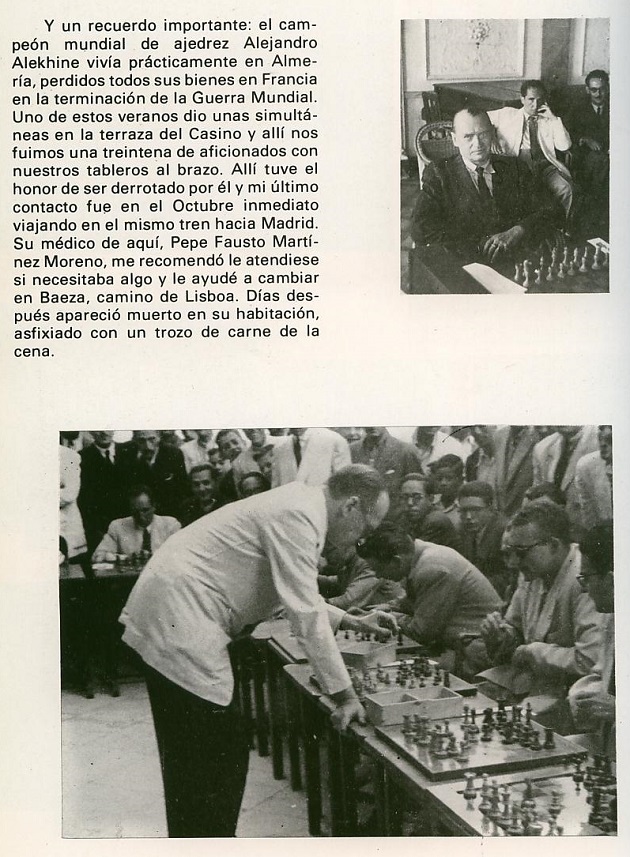
The page is shown here with the permission of the author’s family. Our correspondent adds that the first picture was taken in the Círculo Mercantil, Almería. The person immediately behind Alekhine is Francisco López Núñez, who won the Almería tournament (21-29 August 1945) jointly with the world champion. The second photograph shows a simultaneous display by Alekhine on the terrace of the Almería Casino on 30 August 1945. He is at the board of Artero García.
10902. Golombeks
From the ‘Foreign and Dominion News’ column, edited by Harry Golombek, on page 6 of the January 1954 BCM:
‘Whilst on this subject of confusion it is perhaps worth pointing out that the Golombek who won the championship of Aschaffenburg so easily recently, with the score of 12 points out of 13, is not H. Golombek of England. Nor, as far as we know, is there any relationship – the name, though a rara avis here, is fairly common in Poland, Czechoslovakia and North Germany. Those of our readers who have read War with the Newts by that great Czech writer Karel Čapek may recall that mention is made there of an editor named Golombek.’
10903. A.G. Condé
A tribute to Adrián García Condé (1886-1943) by William Winter was published on pages 202-204 of the September 1943 BCM:
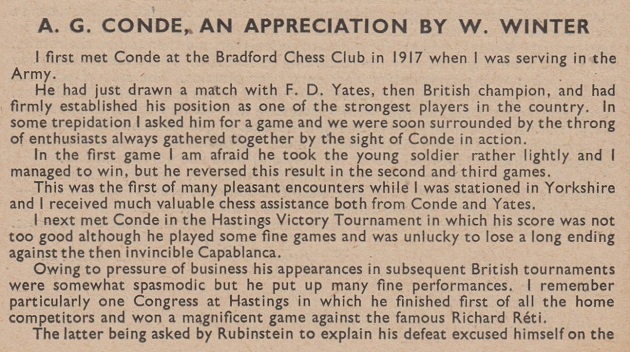

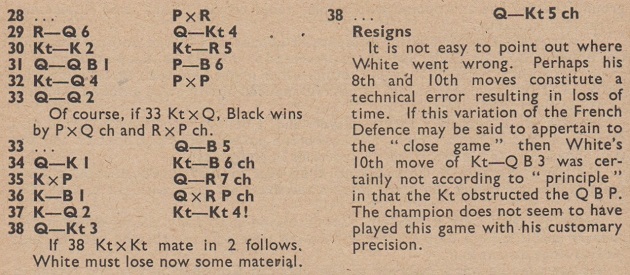
1 e4 e6 2 d4 d5 3 Nc3 Nf6 4 Bg5 Be7 5 e5 Nfd7 6 Bxe7 Qxe7 7 Nb5 Qd8 8 Qg4 g6 9 f4 a6 10 Nc3 c5 11 Nf3 Nc6 12 O-O-O cxd4 13 Nxd4 Nxd4 14 Rxd4 Qb6 15 Qd1 Nc5 16 g4 Bd7 17 Bg2 Bc6 18 Re1 O-O-O 19 Re3 h5 20 g5 Rd7 21 a3 Rhd8 22 Na2 Kb8 23 Rc3 Rc7 24 Nb4 Bb5 25 Kb1 a5 26 Na2 Rdc8 27 Nc1 Bc4
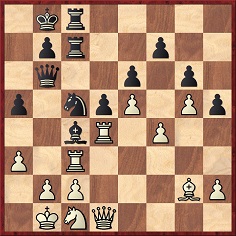
28 Rcxc4 dxc4 29 Rd6 Qb5 30 Ne2 Na4 31 Qc1 c3 32 Nd4 cxb2 33 Qd2 Qc4 34 Qe1 Nc3+ 35 Kxb2 Qa2+ 36 Kc1 Qxa3+ 37 Kd2 Nb5 38 Qg3 Qb4+ 39 White resigns.
Those notes by Condé to his victory over Yates were reproduced from pages 57-58 of the February 1919 BCM, whose previous page had this miniature against J.R. Deacon (given on pages 121-122 of Kings, Commoners and Knaves and in Royal Walkabouts):
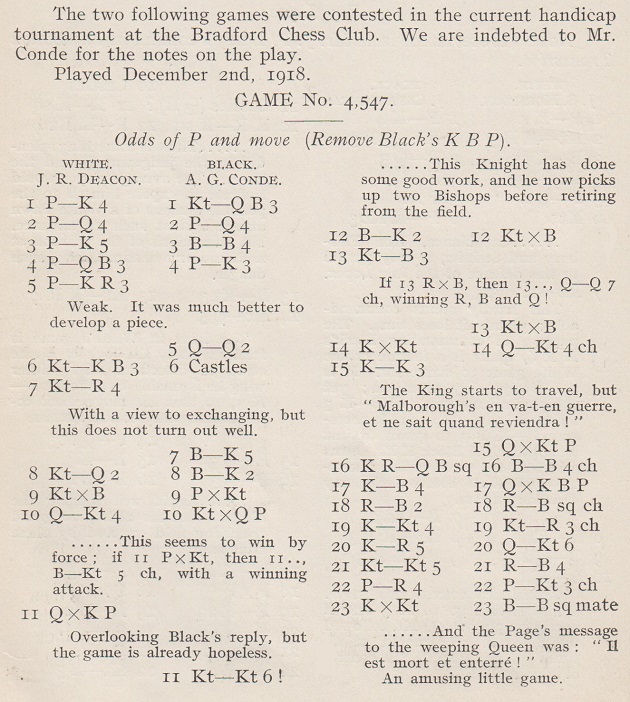
1 e4 Nc6 2 d4 d5 3 e5 Bf5 4 c3 e6 5 h3 Qd7 6 Nf3 O-O-O 7 Nh4 Be4 8 Nd2 Be7 9 Nxe4 dxe4 10 Qg4 Nxd4 11 Qxe4
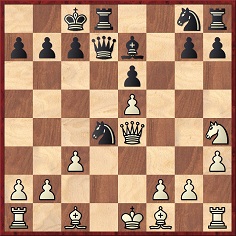
11...Nb3 12 Be2 Nxc1 13 Nf3 Nxe2 14 Kxe2 Qb5+ 15 Ke3 Qxb2 16 Rhc1 Bc5+ 17 Kf4 Qxf2 18 Rc2 Rf8+ 19 Kg4 Nh6+ 20 Kh5 Qg3 21 Ng5 Rf5 22 h4
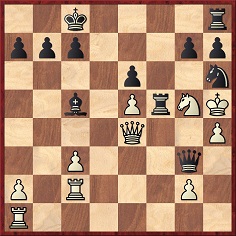
22...g6+ 23 Kxh6 Bf8 mate.
Regarding William Winter’s suggestion that Condé ‘hardly ever looked at a chess book’, the following ‘is said to have’ remark appeared on page 11 of the Hastings and St Leonards Observer, 6 July 1929 and, without any mention of that newspaper, on page 243 of the Chess Amateur, August 1929:
‘Mr A.G. Condé, the Mexican chessplayer, who took part in the recent little tourney at the Gambit Café, London, is said to have learnt chess when 14 years of age by studying the Hastings Chess Tournament Book of 1895. This was the first book he studied from, and in a few months [he] played over every game in the volume, carefully following the notes. In due time he became a first-class player.’
10904. Grandmasters
Concerning the origins of the grandmaster title, Morten Lilleøren (Oslo) notes the Großmeister references on pages 9-10 of Siegbert Tarrasch’s introduction to his Ostend, 1907 tournament book:
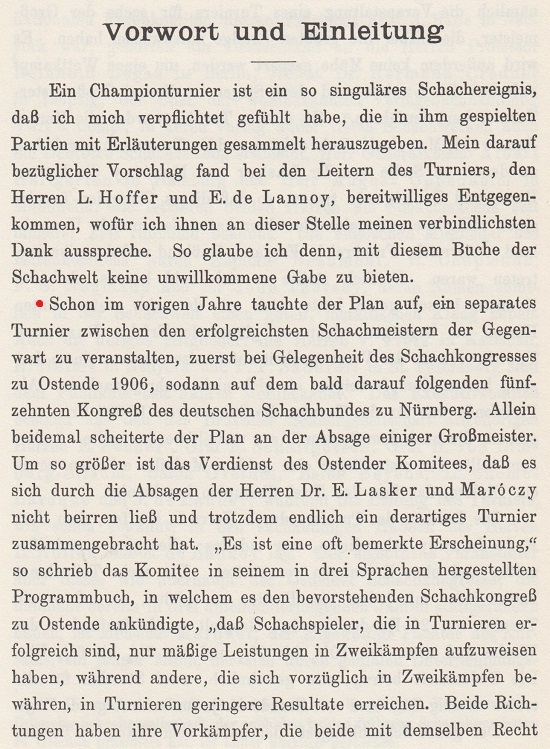
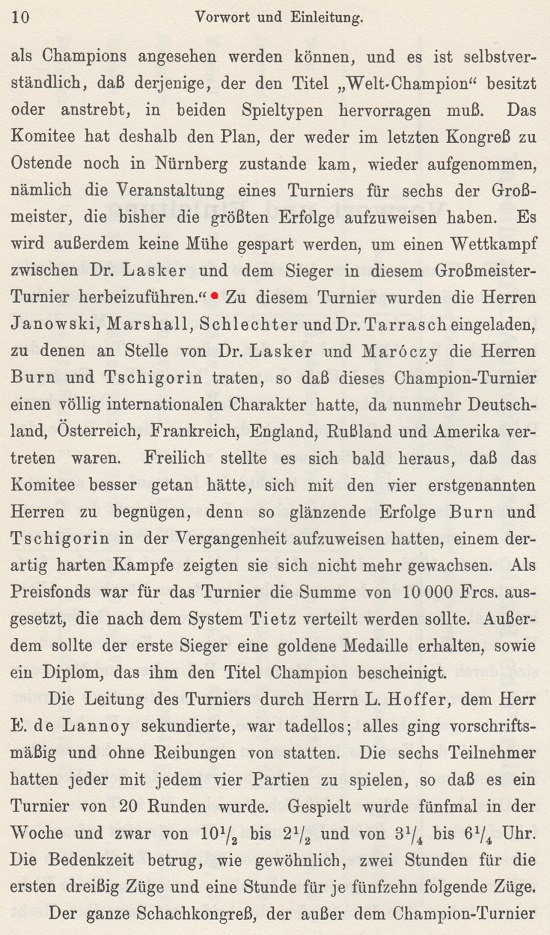
An immediate question is whether any reader has access to the trilingual Programmbuch.
10905. The 1953 Candidates’ tournament
From Olimpiu G. Urcan (Singapore):
‘The Swiss Federal Archives have some rare chess footage, including an 84-second segment on the last round and prize ceremony of the Candidates’ tournament in Switzerland on 23 October 1953. It features, among others, Bronstein, Keres, Reshevsky, Smyslov and Taimanov.’
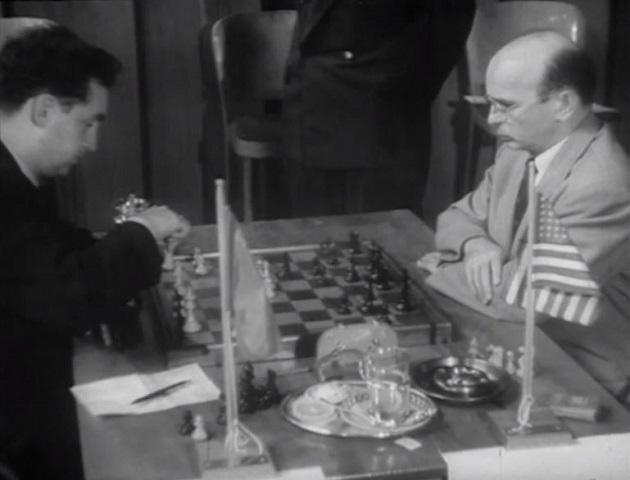
Mark Taimanov and Samuel Reshevsky
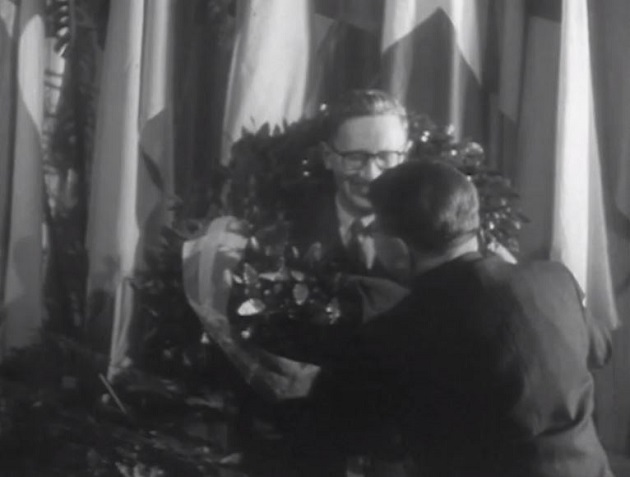
Vassily Smyslov
10906. Greed
‘Despite all the strictures against greed, nearly all players succumb to the temptation to grab first and think it over later.’
Source: page 22 of 1000 Best Short Games of Chess by Irving Chernev (New York, 1955).
10907. Unexplained
From the Daily News (New York), 3 December 1922, page 46 (section two):
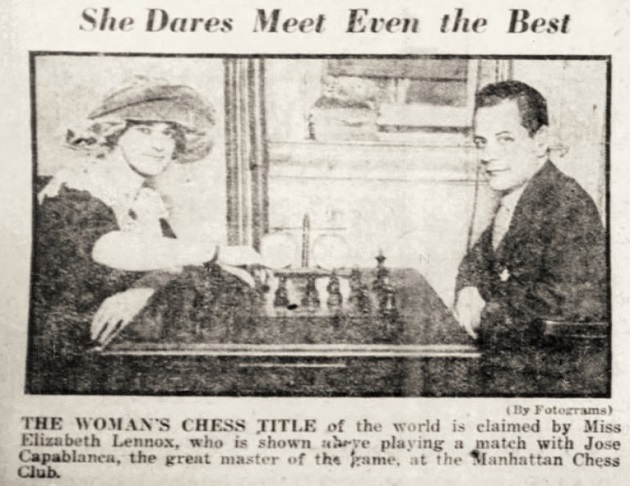
10908. The Marshalls
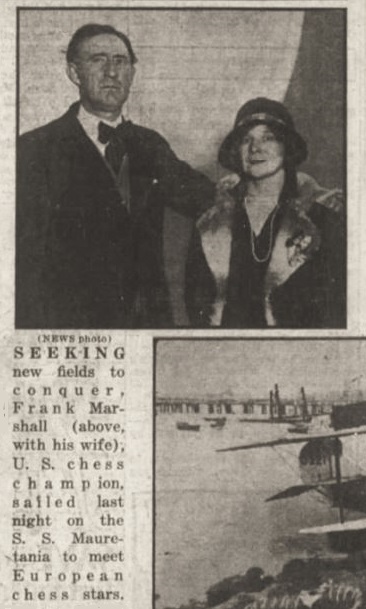
Source: Daily News (New York), 29 September 1927, page 21 (section two).
Marshall participated in the British Empire Club Masters’ Tournament in London, which began on 10 October 1927. A group photograph (the frontispiece to the November 1927 BCM) was shown in C.N. 3959. Reporting on Marshall’s departure from New York, page 151 of the September-October 1927 American Chess Bulletin commented that ‘Marshall’s last appearance in an English tournament was in 1899’.
10909. Capablanca v Marshall, New York, 1918
The present item discusses two analytical points in Capablanca v Marshall, New York, 1918 (which began 1 e4 e5 2 Nf3 Nc6 3 Bb5 a6 4 Ba4 Nf6 5 O-O Be7 6 Re1 b5 7 Bb3 O-O 8 c3 d5 9 exd5 Nxd5 10 Nxe5 Nxe5 11 Rxe5 Nf6 12 Re1 Bd6 13 h3 Ng4 14 Qf3 Qh4 15 d4 Nxf2 16 Re2 Bg4 17 hxg4 Bh2+ 18 Kf1 Bg3 19 Rxf2 Qh1+ 20 Ke2 Bxf2).
Firstly, an analytical oversight by Capablanca:
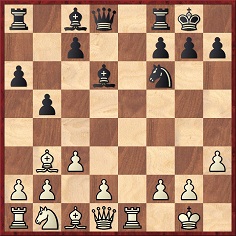
Position after 13 h3
Marshall now played 13...Ng4, and the Cuban wrote in My Chess Career:

Page 157 of the 1994 algebraic edition of My Chess Career changed Capablanca’s words and added an editorial note in italics:

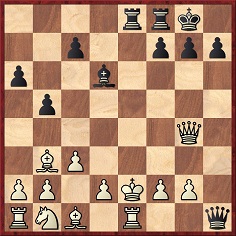
Position in Capablanca’s analysis after 18...Rae8+
Lest it be assumed that 19 Be6 was a suggestion original to that 1994 book, we show, firstly, what had appeared on pages 104-105 of Kapablanka by V. Panov (Moscow, 1959):
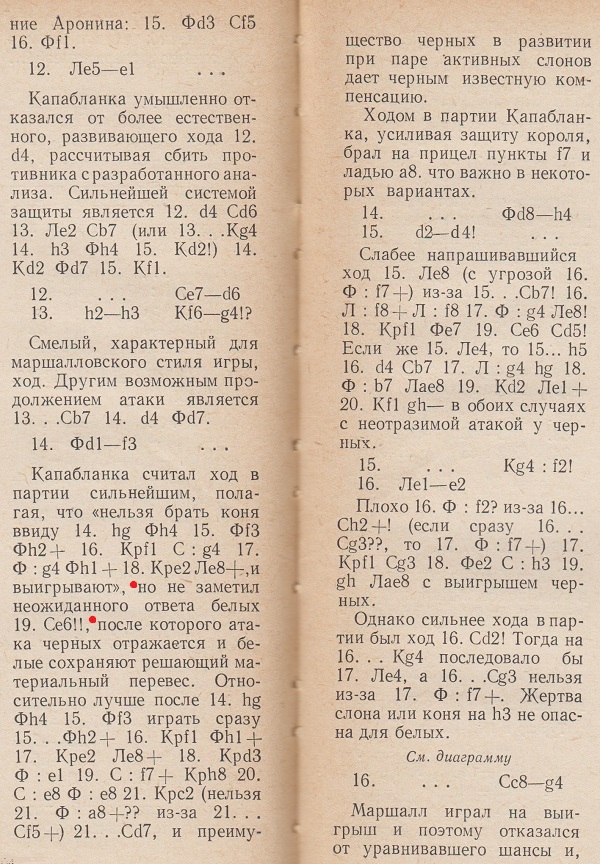
On page 141 of a subsequent (1970) monograph on the Cuban, Panov ascribed the discovery of 19 Be6 to E. Palkin of Leningrad, 36 years after the game was played:
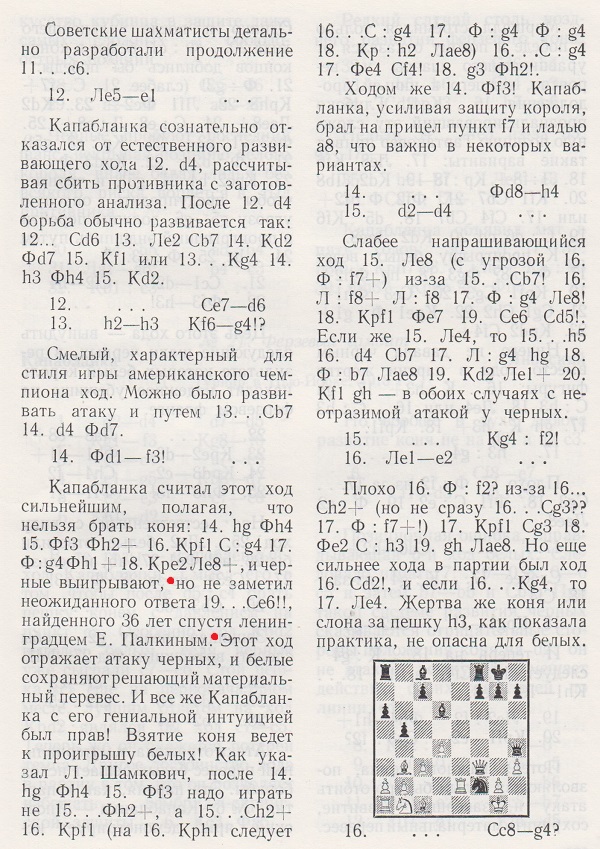
Palkin was also mentioned by Leonid Shamkovich in an article about the game on pages 28-30 of the September 1985 Chess Life:
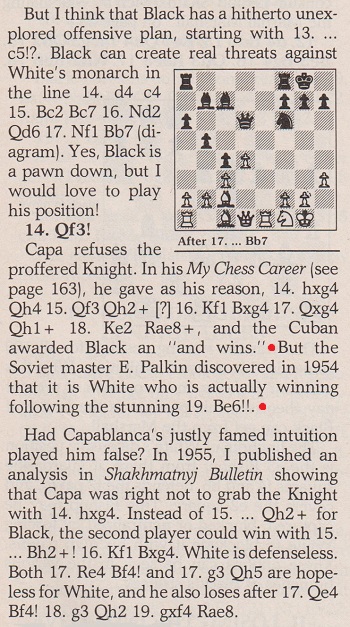
Wanted: more information about the discovery of 19 Be6 by E. Palkin in the mid-1950s and, more generally, about Palkin himself.
The second, less intricate, analytical point concerns the board position after Marshall’s move 15...Nxf2:
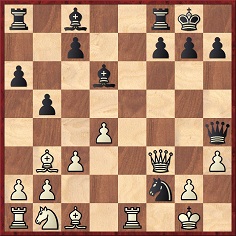
From page 164 of the March 1919 Chess Amateur:
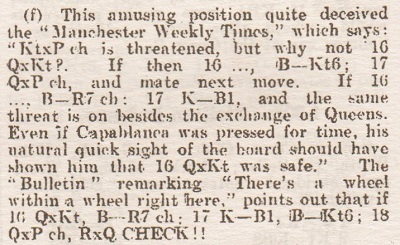
Does a reader have access to the Manchester Weekly Times (chess columnist: V.L. Wahltuch)?
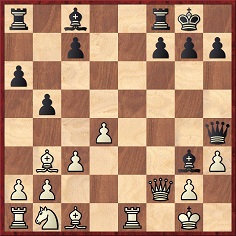
White plays 17 Qxf7+
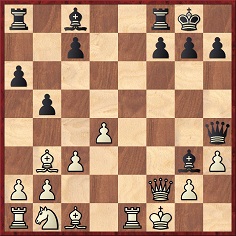
White does not play 18 Qxf7+.
10910. Capablanca v Marshall, New York, 1918 (C.N. 10909)
Olimpiu G. Urcan (Singapore) has found this picture in the photogravure section (pages unnumbered) of the Baltimore Sun, 1 December 1918:

10911. Chaos in a miniature
Also courtesy of Olimpiu G. Urcan is this early publication of the Edward Lasker v George Thomas miniature in O.C. Müller’s column in The Globe, 9 November 1912, page 8:
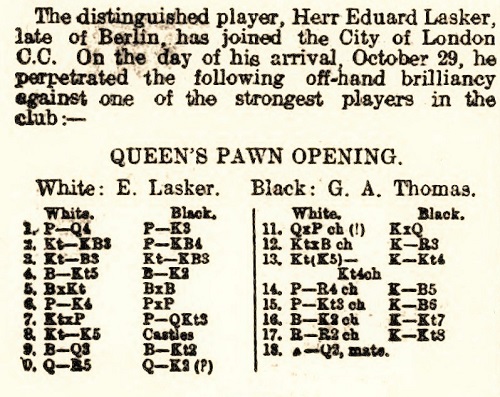
10912. A mysterious composition (C.N.s 145, 187, 2705 & 10146)
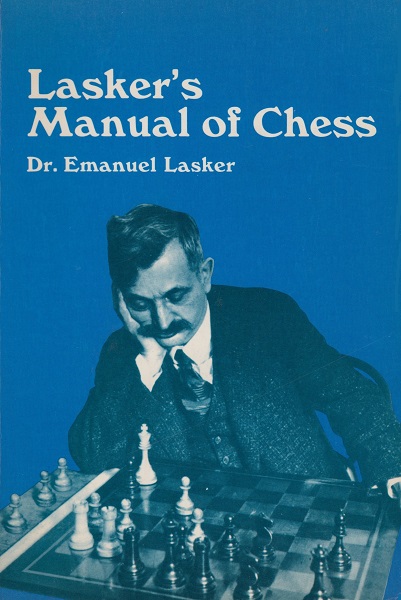
C.N. 10146 noted that the above photograph of Emanuel Lasker can be viewed at the website of the Center for Jewish History. The composer has still not been identified.
Steve Wrinn (Homer, NY, USA) adds that in one of the photographs in the Los Angeles Times Photographic Archive mentioned in C.N. 10892 the board position being examined by Lasker was similar (a mate in five), both pictures having been taken during the former world champion’s visit to the Los Angeles Athletic Club in March 1926.
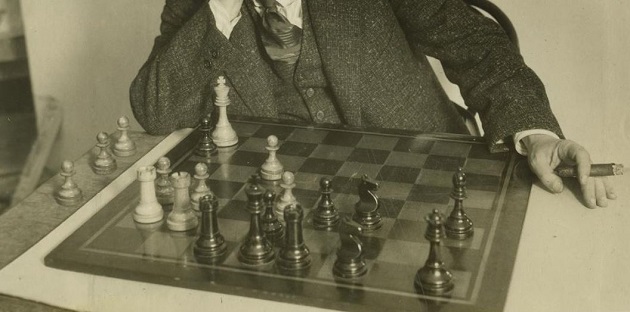
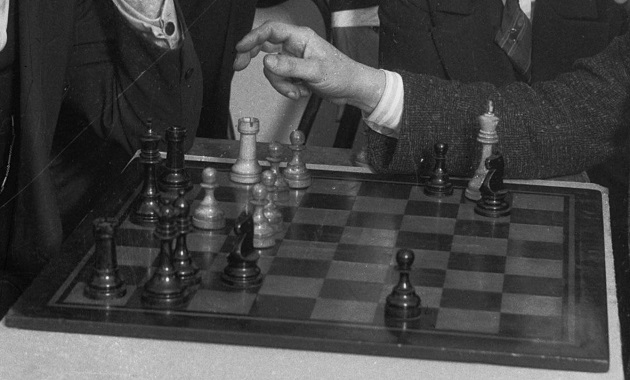
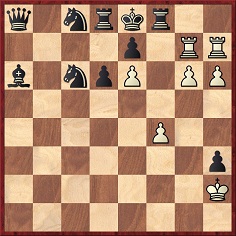
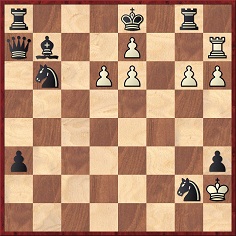
10913. Budapest, 1896
The group photograph of Budapest, 1896 is fairly well known – see, for instance, page 5 of John C. Owen’s tournament book (Yorklyn, 1994) – but a particularly good version was published on page 793 of the 22 November 1896 edition of Vasárnapi Ujság (with Marco and Maróczy’s names transposed):
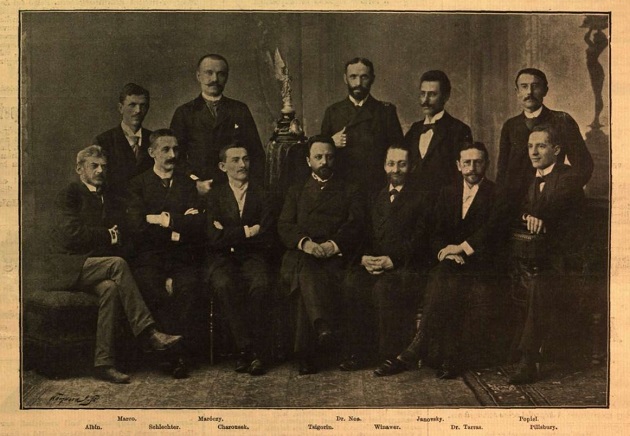
10914. Capablanca v Marshall, New York, 1918 (C.N. 10909)

White can play 19 Be6
The request in C.N. 10909 for information about the publication in which E. Palkin reported that analysis by Capablanca in My Chess Career missed 19 Be6 has been answered by Andrey Terekhov (Singapore) and Vitaliy Yurchenko (Uhta, Komi, Russian Federation), both of whom have provided page 50 (‘Readers’ letters’) of the 2/1954 issue of Shakhmaty v SSSR:
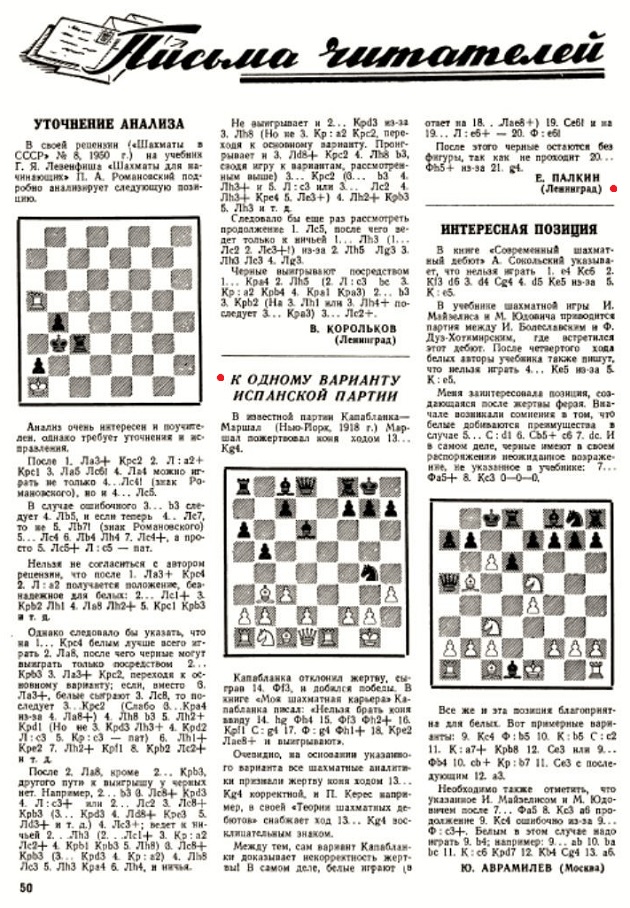
10915. Tartakower on Schlechter
James Lanning (Bloomington, IN, USA) draws attention to this curious passage on page 442 of Die hypermoderne Schachpartie by Savielly Tartakower (Vienna, 1924):

Tartakower’s essay in Spielmann’s monograph on Schlechter is given below in full. It appeared under the pseudonym ‘Spielmann’ in the sense that it was in Spielmann’s book without any indication of authorship, thus leaving readers to assume that the three and a half pages were by Spielmann himself.
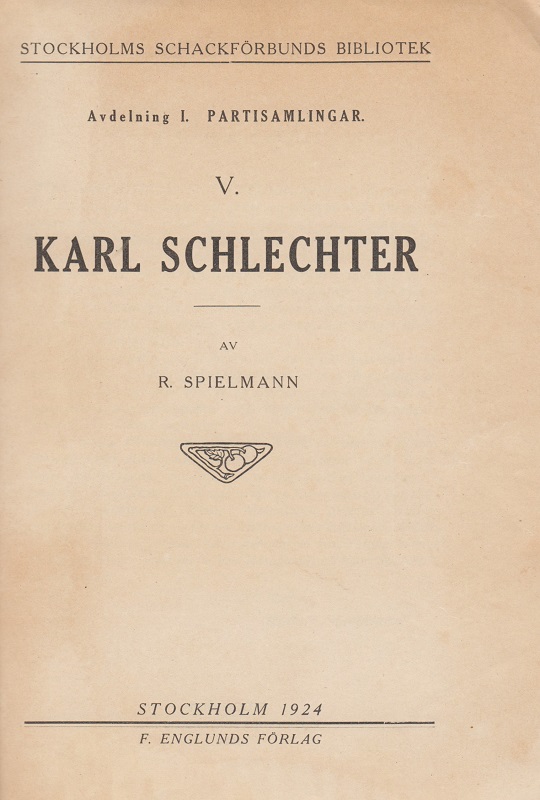
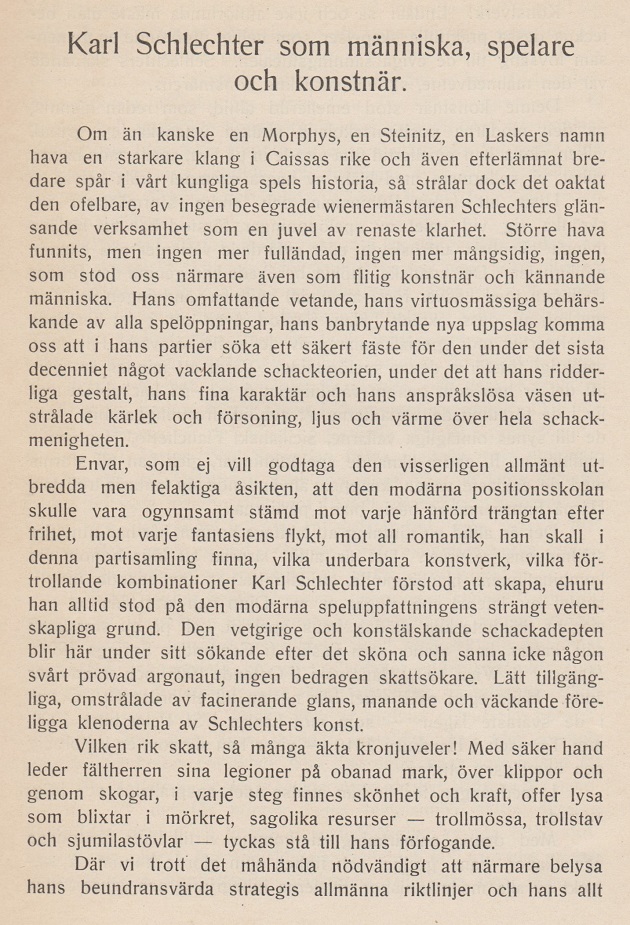
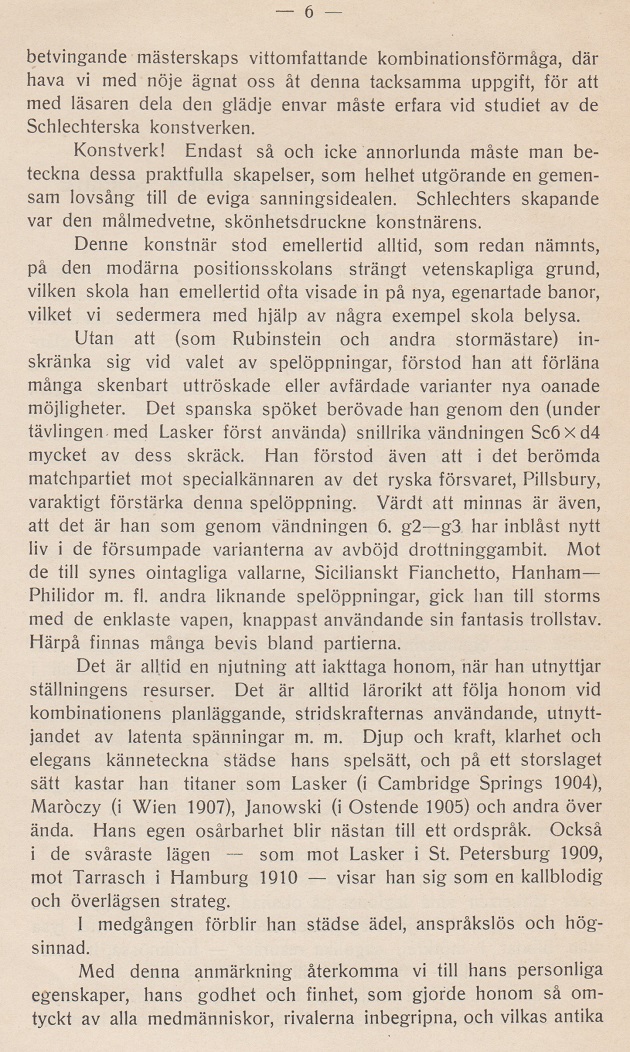

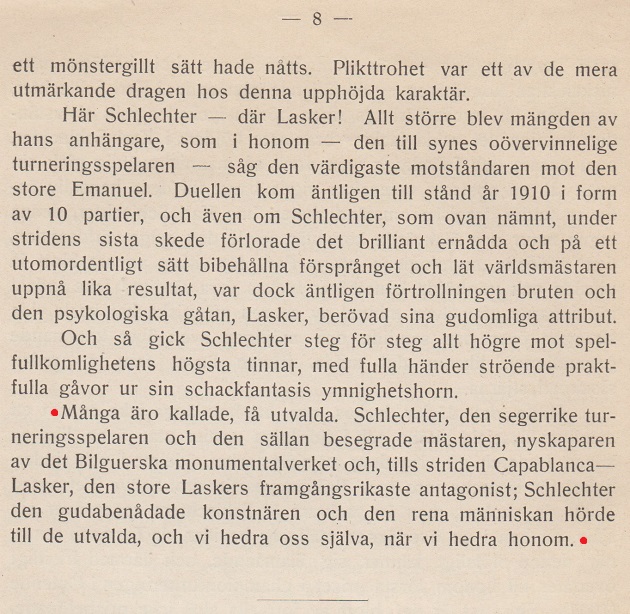
The passage in Die hypermoderne Schachpartie mentioned by our correspondent was mistranslated in the disastrous English edition (see C.N.s 9701 and 10408) of Tartakower’s book, The Hypermodern Game of Chess (Milford, 2015):
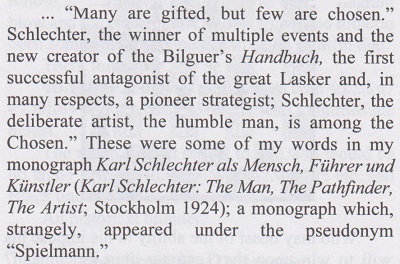
10916. Swedish photographs
Gerard Killoran (Ilkley, England) notes a series of chess-related photographs at the Arkivkopia website. In particular, there is a magnificent portrait of Alekhine.
10917. Pillsbury v Thompson
Another contribution from Gerard Killoran is a blindfold game between H.N. Pillsbury and Guy M. Thompson in the latter’s chess column on page 3 of Part II of the Minneapolis Journal, 12 January 1901:

1 d4 d5 2 c4 e6 3 Nc3 Nf6 4 Bg5 Be7 5 e3 Nbd7 6 Nf3 O-O 7 Bd3 dxc4 8 Bxc4 b6 9 O-O Bb7 10 Rc1 c5 11 Qe2 Ne4 12 Bf4 Nxc3 13 Rxc3 Bxf3 14 Qxf3 cxd4 15 exd4 Bg5 16 Bd6 Be7 17 Bg3 Bh4 18 Bd6 Be7 19 Bxe7 Qxe7 20 Bd3 Nf6 21 Rfc1 Qb4 22 g4 Qxd4

23 Qxa8 Rxa8 24 Rc8+ Qd8 25 Rxd8+ Rxd8 26 Ba6 g6 27 Rc7 Nxg4 28 Rxa7 Rd2 29 b4 Rxa2 30 b5 Rd2 31 Rc7 Nf6 32 Bb7 Nd5 33 Rc8+ Kg7 34 Bc6 Rb2 35 Rb8 Ne7 36 Bd7 Nd5 37 Bc6 Drawn.
The page also has some games of checkers played by Pillsbury.
10918. Tartakower on bizarre openings
The opening paragraph of the article ‘My Bizarre Openings’ by Savielly Tartakower on pages 414-415 of CHESS, 14 August 1938:
‘I regard my openings not so much “bizarre” as psychological, for there is much more risk of going wrong when one adopts a well-known and hackneyed opening than when one succeeds in putting one’s opponent off his balance at the very outset by some totally unexpected coup. The worse a move seems at first sight, the more effective it may be. I refuse to admit that chance does not enter into chess; chance is the measure of human ignorance, and an opponent who, through over-confidence or alarm – two emotions commonly engendered by an apparently “bad” move in the opening – allows his perception of the possibilities and therefore his knowledge of them to be lessened is allowing the chances to pile up against him.’
10919. Oldest chess photograph (C.N.s 5977, 5985 & 10119)
Marek Soszynski (Birmingham, England) points out an article entitled ‘The Puzzling Chess Players’ by Larry J. Schaaf.
10920. Queen offer on b6
An unusual, if straightforward, queen offer occurred in this game between Bodenstein and von Scheve in the Winterturnier der Berliner Schachgesellschaft which was published on pages 6-7 of the Schachjahrbuch für 1899 by Ludwig Bachmann (Ansbach, 1900):
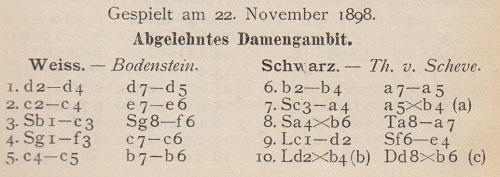
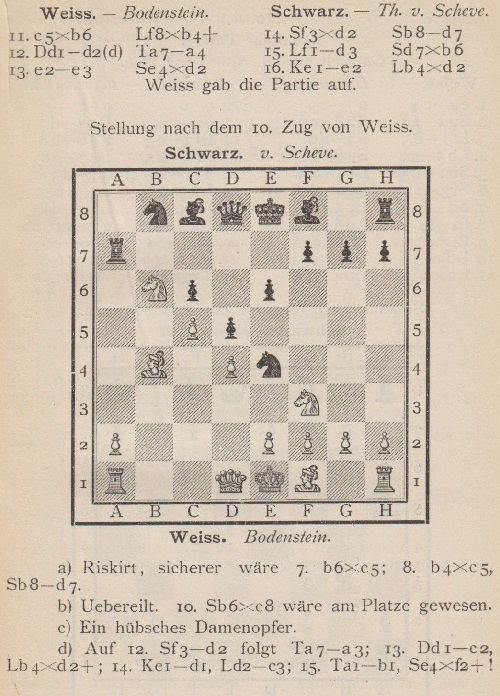
1 d4 d5 2 c4 e6 3 Nc3 Nf6 4 Nf3 c6 5 c5 b6 6 b4 a5 7 Na4 axb4 8 Nxb6 Ra7 9 Bd2 Ne4 10 Bxb4 Qxb6 11 cxb6 Bxb4+ 12 Qd2 Ra4 13 e3 Nxd2 14 Nxd2 Nd7 15 Bd3 Nxb6 16 Ke2 Bxd2 and wins.
Annotating the game on pages 154-155 of Der Schachfreund, December 1898, von Scheve indicated that play continued a little after 16...Bxd2: ‘und Weiss gab nach einigen weiteren Zügen das völlig aussichtslose Spiel auf’.
10921. Chess enthusiast and mathematician
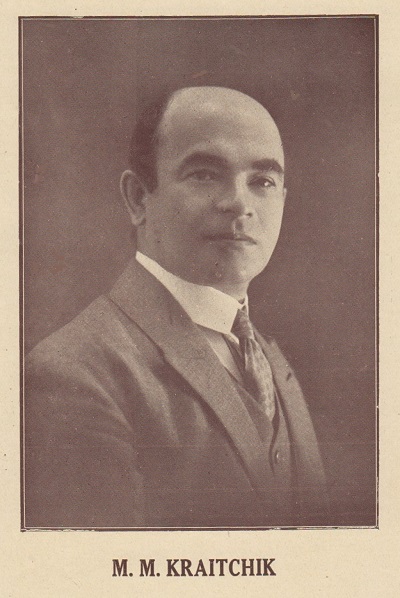
L’Echiquier, 30 September 1930, opposite page 940
A biographical note on Maurice Kraïtchik was published on page 995 of the same issue:

The Belgian magazine published a regular column of mathematical puzzles by Kraïtchik, firstly using the pseudonym ‘Sphynx’ and later (as from page 883 of the January 1928 issue) under his own name. Information is sought regarding the chess activities, as indicated in the above text, of this eminent mathematician.
10922. Capablanca v Jaynes
Gerard Killoran (Ilkley, England) has forwarded a simultaneous game published on page 39 of the Minneapolis Sunday Tribune, 21 February 1909:
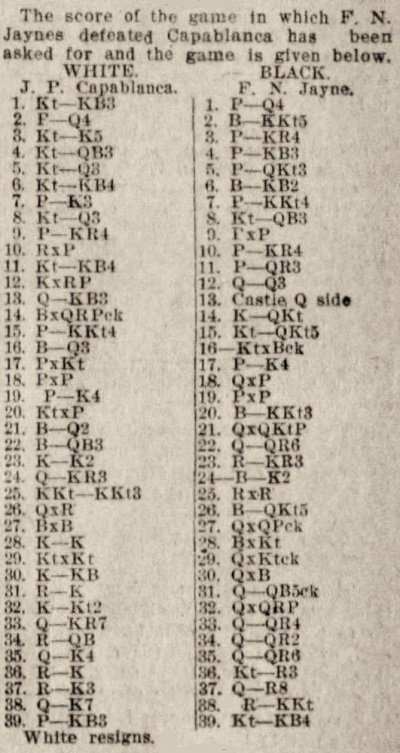
1 Nf3 d5 2 d4 Bg4 3 Ne5 Bh5 4 Nc3 f6 5 Nd3 b6 6 Nf4 Bf7 7 e3 g5 8 Nd3 Nc6 9 h4 gxh4 10 Rxh4 h5 11 Nf4 a6 12 Nxh5 Qd6 13 Qf3 O-O-O 14 Bxa6+ Kb8 15 g4 Nb4 16 Bd3 Nxd3+ 17 cxd3 e5 18 dxe5 Qxe5 19 e4 dxe4 20 Nxe4 Bg6 21 Bd2 Qxb2 22 Bc3 Qa3 23 Ke2 Rh6 24 Qh3 Be7 25 Nhg3 Rxh4 26 Qxh4 Bb4 27 Bxb4 Qxd3+ 28 Ke1 Bxe4 29 Nxe4 Qxe4+ 30 Kf1 Qxb4 31 Re1 Qc4+ 32 Kg2 Qxa2 33 Qh7 Qa5 34 Rc1 Qa7 35 Qe4 Qa3 36 Re1 Nh6 37 Re3 Qa1 38 Qe7 Rg8 39 f3
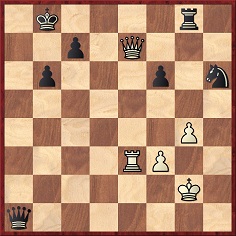
39...Nf5 40 White resigns.
Of the two versions of Black’s surname in the newspaper heading, Jaynes is correct. Page 15 of our book on Capablanca pointed out that this game was the first loss in his first simultaneous tour of the United States and, on the basis of a transcript from page 10 of the Minneapolis Tribune of 23 January 1909 (a column too faint to reproduce) received from a local library, gave the victor’s name as P.N. Jaynes. We note now that the Tribune of the time had many references to F.N. Jaynes, and that page 37 of the 31 January 1909 edition named him as Fremont N. Jaynes.
The game was included without a source in Rogelio Caparrós’ volumes on Capablanca with the misspelling Jayne and with 33...Qa4 instead of 33...Qa5.
10923. FIDE politics: a basic question
To cut to the chase, we should like to see one question answered, succinctly and in writing, by anybody who aspires to lead FIDE:
If you are elected FIDE President, what are the main specific changes that the chess world will see A) after one year, and B) after four years?
10924. E. Palkin (C.N. 10909)
Vitaliy Yurchenko (Uhta, Russian Federation) suggests that Leonid Shamkovich was mistaken when he referred to E. Palkin as a master on page 29 of the September 1985 Chess Life (cutting shown in C.N. 10909). Our correspondent notes that page 39 of the October 1957 issue of Shakhmaty v SSSR reported on a Leningrad tournament in which Palkin participated. He was not named among the masters or candidate masters. That he subsequently became a candidate master is shown by page 210 of Lyudi i Shakhmaty by J. Dlugolensky and V. Zak (Leningrad, 1988). Pages 251-254 of that book listed pre-1988 masters from Leningrad, and Palkin was not among them.
10925. Charles Jaffe
Photographs of Charles Jaffe are scarce and usually of poor quality. Below, for instance, is page 204 of the September 1909 American Chess Bulletin:
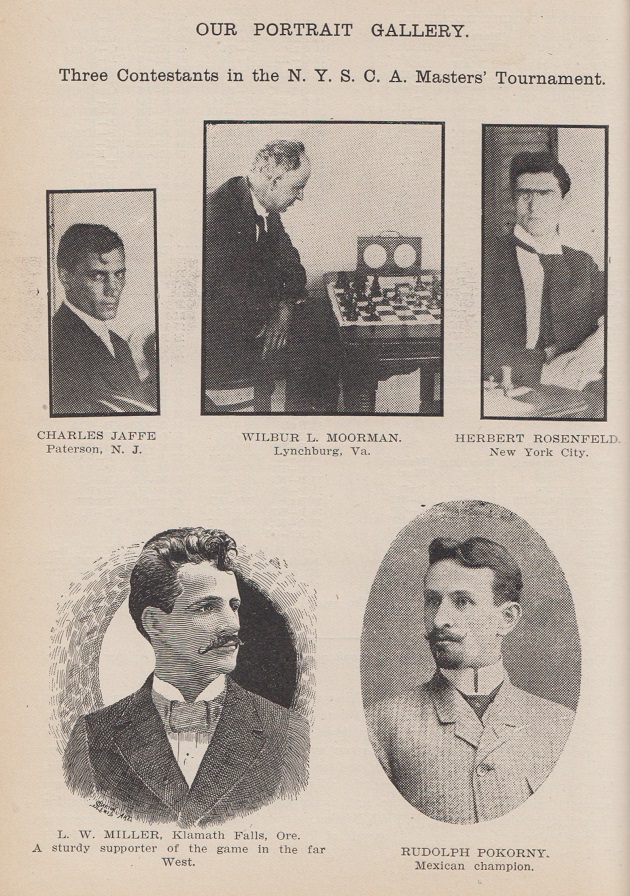
Olimpiu G. Urcan (Singapore) has found the following on page 15 of the Buffalo Sunday Morning News, 12 February 1911:
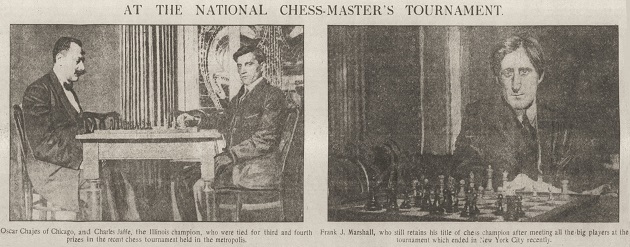
10926. Newspaper cuttings
A further set of newspaper cuttings has been received from Olimpiu G. Urcan:
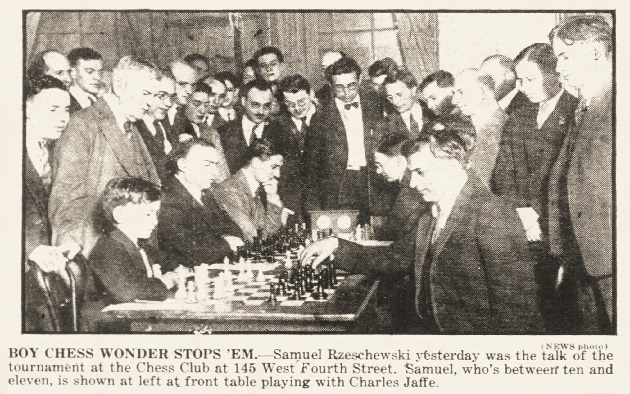
Daily News (New York), 10 October 1922, page 12
C.N. 6083 showed a later publication of this photograph (page 158 of the November 1922 American Chess Bulletin).

Baltimore Sun, 2 March 1924, page 4, part 1, section 2
The article is notable for the accuracy of Jaffe’s prediction about New York, 1924 and for his general remark about the arduousness of such events:
‘... playing in an international chess tournament requires as much physical endurance as a six-day bicycle race.’
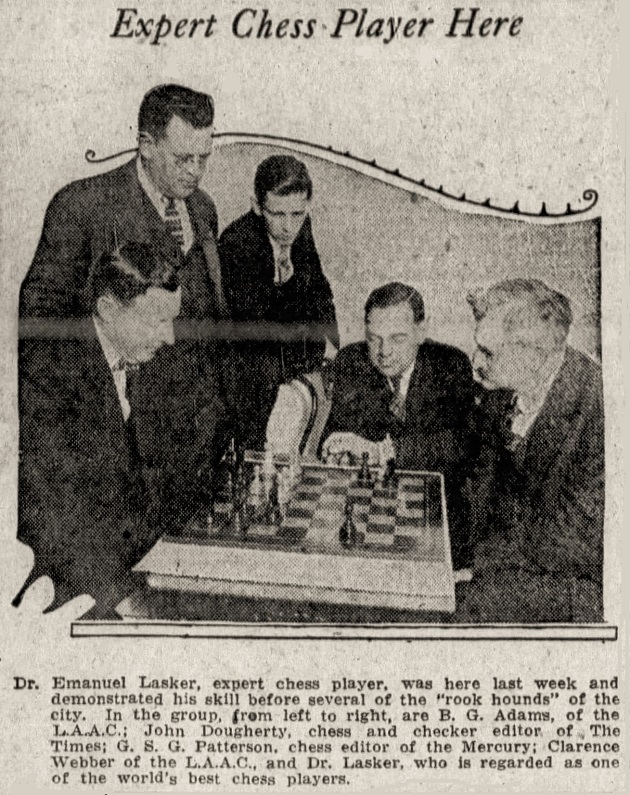
Los Angeles Times, 4 April 1926, page 13 (part VI)
The caption to this slightly different group photograph
adds some information to that given in C.N.s 10892 and
10912.

Courier and Advertiser (Dundee), 24 November 1930, page 5
Concerning Znosko-Borovsky in Dundee, see C.Ns. 6809 and 6810.
10927. Najdorf in Israel
Avital Pilpel (Haifa, Israel) writes:
‘I have from Professor Ami Barav this high-quality photograph of Najdorf during his visit to Israel in 1960-61:
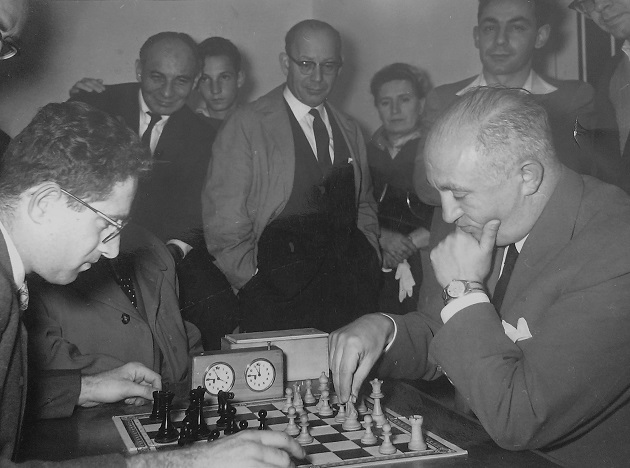
The identity of Najdorf’s opponent is uncertain. Standing on the left is Israel Barav (Rabinovich), and behind him is his son, Ami. The venue may well be the Réti Club in Tel Aviv.’
10928. Alekhine’s articles
Regarding the Alekhine ‘Nazi articles’, William D. Rubinstein (Melbourne, Australia) asks whether further information is now available as to the possible release of the original texts written by Alekhine. In 2005 (C.N. 3617) we wrote:
French copyright law changed in the mid-1990s, and Article L123.1 of the current Code de la propriété intellectuelle provides for a term of 70, not 60, years post mortem auctoris. (Similar amendments of national laws were made throughout the European Union, following on from the ‘Council Directive 93/98/EEC of 29 October 1993 harmonizing the term of protection of copyright and certain related rights’.) In the absence of special circumstances the Alekhine ‘Nazi articles’ will enter into the public domain on 1 January 2017.
10929. The complexity of chess
‘Chess is so complex that it is given to a very small minority of players, throughout their lives, ever to conduct a really good game over the board.’
Source: Australasian Chess Review, 8 October 1936, page 273 (in an article by C.J.S. Purdy).
10930. Consultation games
Jean-Pierre Rhéaume (Montreal, Canada) asks whether contemporary descriptions are available of the practical conditions under which consultation games used to be played, an example being the encounter in Budapest in 1921 between Alekhine, Sämisch, Steiner, Tartakower and Vajda on one side and, on the other, Abonyi, Bogoljubow, Grünfeld, Kostić and Sterk (C.N.s 8308 and 8592).
10931. Chess Fever (C.N.s 3987 & 3992)
Olimpiu G. Urcan (Singapore) provides an extract from pages 174-175 of Kino: A History of the Russian and Soviet Film by Jay Leyda (New York, 1960):

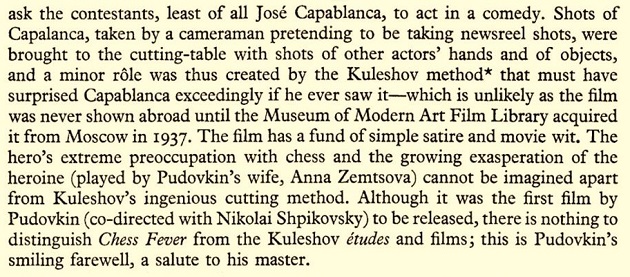

10932. Abe Turner
From page 7 of the Daily News (New York), 26 October 1962:

The death of Abe Turner was discussed in C.N.s 1286 and 1311 (see pages 126-127 of Chess Explorations and Chess and Murder). C.N. 1311 quoted a newspaper report that the killer was Theodore Weldon Smith, a 35-year-old handyman. A photograph of Turner in play against Fischer is in C.N. 6423.
From page 195 of the July 1962 Chess Review:
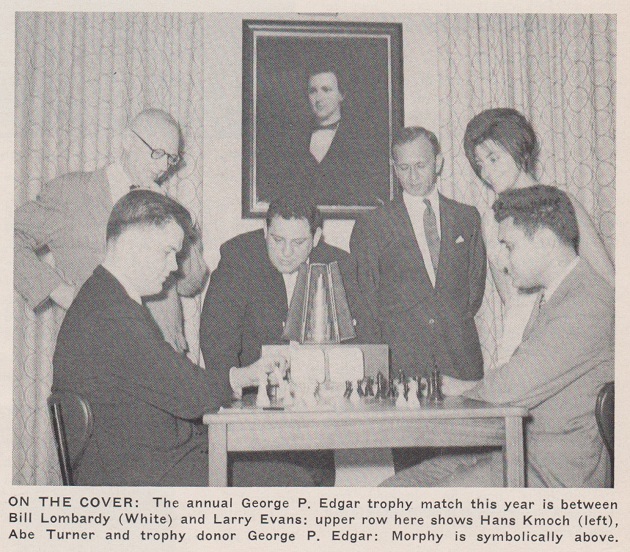
A paragraph from page 290 of the October 1961 Chess Life:
‘US Master Abe Turner became a movie actor. We spotted him in a party scene of artist-beatniks in a highly humorous film, [A] Bowl of Cherries. He shakes hands with the star.’
We have no further information about the film beyond what is readily available online.
10933. Ruy López
A paragraph entitled ‘Ruy López a Spanish priest’ on page 189 of the April 1915 Chess Amateur began:
‘Mr W.S. Branch has discovered that Ruy López was a Spanish priest, not, as is sometimes stated, a bishop ...’
What is the best source today, in any language, for biographical information on Ruy López?
10934. Kostić’s memory (C.N. 6331)
C.N. 6331 (see also Memory Feats of Chess Masters) showed that, in reply to a question from C.J.S. Purdy, Boris Kostić denied the claim about his exceptional memory made by Capablanca in My Chess Career.
We note now that Purdy wrote similarly about the claim on page 293 of the Australasian Chess Review, November 1936:
‘Naturally, many people swallowed this, but Kostić told the present writer that it was a wild exaggeration ventured upon by Capablanca for effect.’
10935. Kurt Burger (C.N.s 10576, 10584 & 10630)
Wanted: more information about the painting of Burger on page 132 of the May 1963 Chess Review:

10936. Koltanowski
George Koltanowski could forge an anecdote from the dropping of a paperclip, but even rudimentary verification of his ‘factual statements’ is likely to highlight his unreliability.
On pages 2-3 of the March 1969 Chess Digest he had a chatty article about Tarrasch which we have already criticized for stating a) that he encountered the German master at Meran, 1924 ‘in my early teens’, and b) that Tarrasch ‘played two matches for the world title with Lasker’. (Regarding the latter point, see too A Sorry Case.)
Koltanowski repeated the above inaccuracies in his syndicated column (e.g. in the Minnesota Star, 29 March 1969, page 19, as well as the El Paso Times 29 March 1969, page 21 and 19 October 1969, page 17) and in his section on Tarrasch on pages 48-51 of With the Chess Masters (San Francisco, 1972).
A further example of Koltanowski’s approach concerns the game accompanying that article on Tarrasch: their draw at the 1927 International Team Tournament in London. Koltanowski wrote in 1969 that a friend in Antwerp had recently sent him a number of old booklets and that in one of them, on the King’s Indian Defence, ‘there was one game that I had searched for a long time.’ In the above newspapers and in With the Chess Masters the reference was to a game that ‘I had tried to find for a long time’. In reality, that Tarrasch v Koltanowski game is easily found, having been published on pages 792-793 of L’Echiquier, December 1927 – with annotations by Koltanowski.
In large letters, the title of the Chess Digest article was ‘Koltys Coments’.
10937. Behind the French lines
From page 221 of the May 1915 Chess Amateur:
‘The Daily Mail
Delighted chessplayers with a charming picture of “A Game of Chess Behind the French Lines”. The players evidently enjoyed their game – each face is depicted beaming with interest and pleasure.’
The illustration below comes from page 8 (Picture Gallery) of the 2 April 1915 edition of the Daily Mail and shows scant trace of beaming:
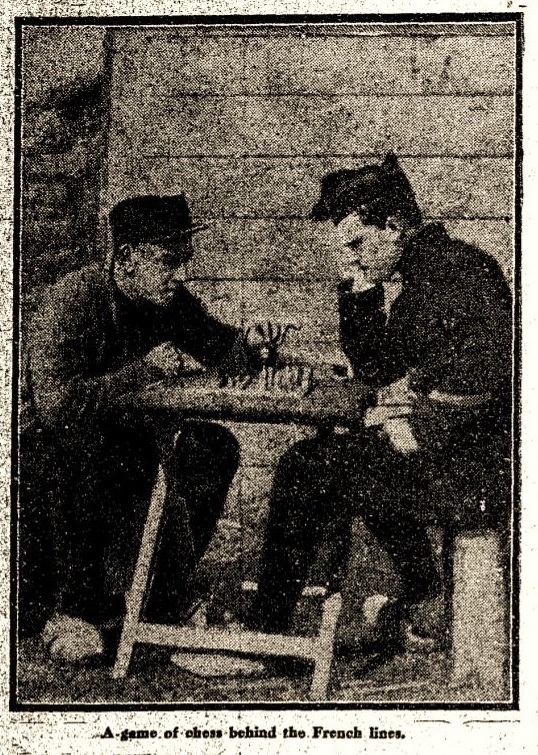
| First column | << previous | Archives [168] | next >> | Current column |
Copyright: Edward Winter. All rights reserved.